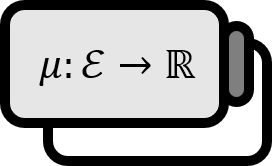Lebesgue-Radon-Nikodym Theorem
Theorem1
A finite measure $\mu$, $\nu$ on a measurable space $(X, \mathcal{E})$ is given. Then, either $\mu \perp \nu$ or there exist $\epsilon>0$, $E \in \mathcal{E}$ satisfying the conditions below.
$$ \mu (E) >0 \quad \text{and} \quad \nu (E) \ge \epsilon \mu (E) $$
Explanation
Although this theorem does not have a specific name, it is used as an auxiliary lemma when proving the Lebesgue-Radon-Nikodym theorem. It contains quite a powerful statement that the relationship between the two finite measures boils down to just one of two possibilities.
Proof
First, for natural numbers $n$, the difference $\nu-\dfrac{1}{n}\mu$ between the given two signed measures becomes a signed measure. Let’s refer to $X=P_{n} \cup N_{n}$ as a decomposition of $\nu-\dfrac{1}{n}\mu$. And let’s define the sets $P$, $N$ as below.
$$ P:= \bigcup _{n=1} ^\infty P_{n} \quad \text{and} \quad N:=P^c=\bigcap _{n=1} ^\infty N_{n} $$
Then, since $N$ is a negative set with respect to $\nu-\dfrac{1}{n}\mu$, the following holds.
$$ \nu (N)-\frac{1}{n}\mu (N) \le 0 \quad \implies \quad \nu (N) \le \frac{1}{n}\mu (N) $$
By assumption, $\mu (N) < \infty$ holds, and since the above equation holds for all $n$, we obtain the following.
$$ \nu (N) =0 $$
Case 1.
Assuming $\mu (P)=0$, then $P\cup N =X$, $P\cap N=\varnothing$ hold, and $P$ is $\nu$-null, $N$ is $\nu$-null, hence the following holds.
$$ \nu \perp \mu $$
Case 2.
Assuming $\mu (P)>0$, then there exists at least one $n$ such that $\mu (P_{n})>0$. And $P_{n}$ is a positive set with respect to $\nu -\dfrac{1}{n}\mu$, hence the following holds.
$$ \nu (P_{n}) -\dfrac{1}{n}\mu ( P_{n}) \ge 0 \quad \implies \quad \nu (P_{n}) \ge \frac{1}{n}\mu (P_{n}) $$
$\dfrac{1}{n}$ and $P_{n}$ become $\epsilon$, $E$ that satisfy the theorem respectively.
■
Gerald B. Folland, Real Analysis: Modern Techniques and Their Applications (2nd Edition, 1999), p89 ↩︎
